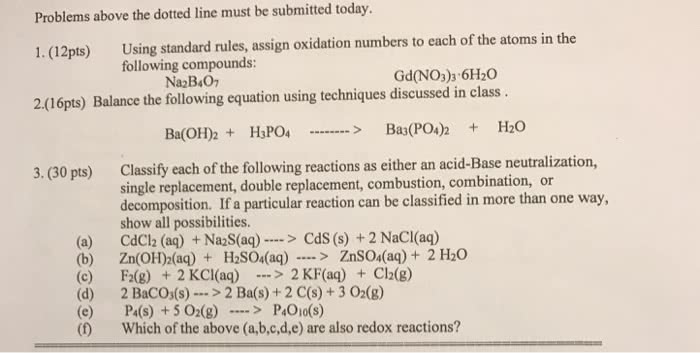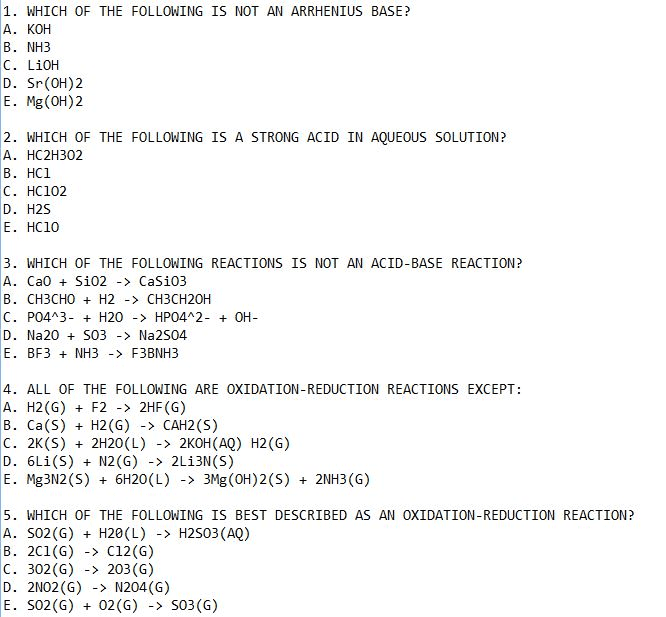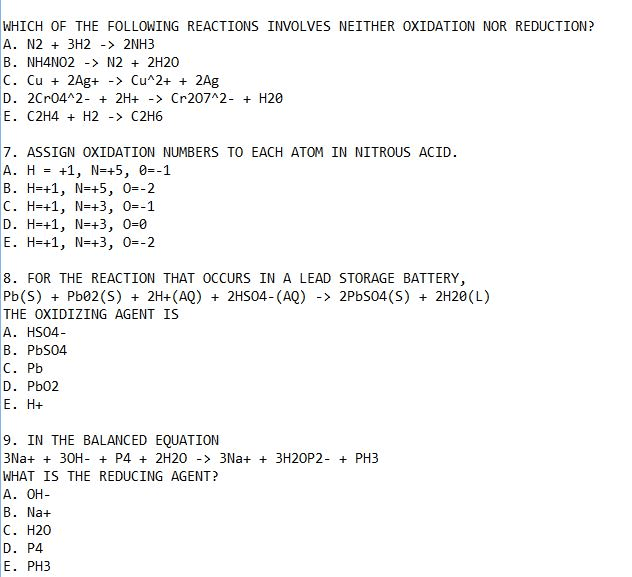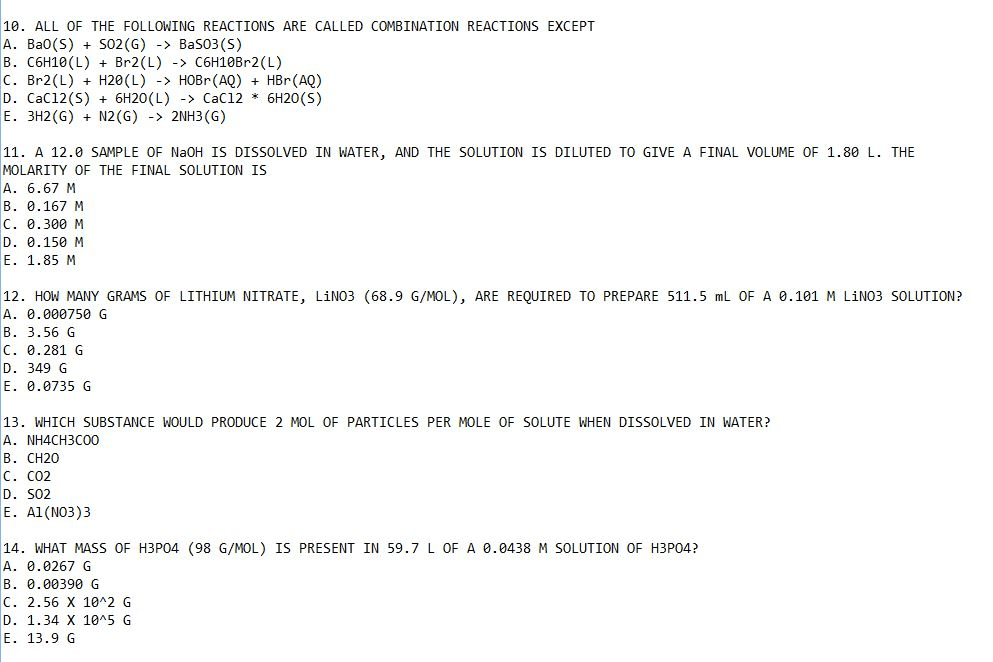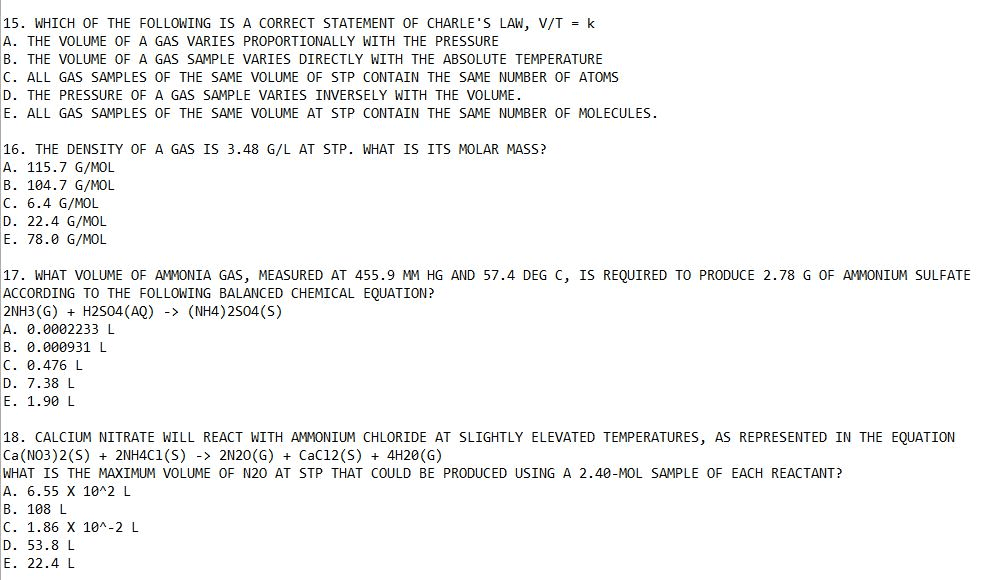Balance the following Chemical Equations:
____Fe(s) + ____H2O(g) ® ____Fe3O4(s) + ____H2(g)
____C2H6(g) + ____O2(g) ® ____CO2(g) + ____H2O(g)
(C) ___ KClO3 (s) ® ___ KCl (s) + ___ O2 (g)
___ C6H14 (l) + ___ O2 (g) ® ___ CO2 (g) + ___ H2O (g)
___ C3H8O3 (l) + ___ O2 (g) ® ___ CO2 (g) + ___ H2O (l)
___ NaN3 (s) ® ___ Na (s) + ___ N2 (g)
__ C3H5N3O9 ® __ CO2 + ___ N2 + ___ H2O + ___ O2
Write and Balance the equations:
Aqueous calcium hydroxide reacts with aqueous sodium carbonate to produce solid calcium carbonate and aqueous sodium hydroxide.
Solid iron reacts with Oxygen gas to form solid Iron (II) oxide
Copper(II) sulfide is oxidized by molecular oxygen to produce gaseous sulfur trioxide and solid copper(II) oxide. The gaseous product then reacts with liquid water to produce liquid hydrogen sulfate as the only product. Write the two equations which represent these reactions.
Indicate what type, or types, of reaction each of the following represents: (precipitation, acid-base, and oxidation-reduction.)
(A) H2O(g) + C(s) ⶠCO(g) +H2(g)
(B) 2KClO3(s) ⶠ2KCl(s) +3O2(g)
(C) Al(OH)3(aq) +3HCl(aq) ⶠAlCl3(aq) + 3H2O(l)
(D) Pb(NO3)2(aq) + H2SO4(aq) ⶠPbSO4(s) + 2HNO3(aq)
4. Silver can be separated from gold because silver dissolves in nitric acid while gold does not. Is the dissolution of silver in nitric acid an acid-base reaction or an oxidation-reduction reaction? Explain your answer.
5. Determine the oxidation states of the elements in the compounds listed. None of the oxygen-containing compounds are peroxides or superoxides.
(A) H3PO4
(B) Al(OH)3
(C) SeO2
6. Complete and balance the following acid-base equations:
(A) A solution of HClO4 is added to a solution of LiOH.
(B) Aqueous H2SO4 reacts with NaOH.
7. Write the molecular, total ionic, and net ionic equations for the following reactions:
(A) Ca(OH)2(aq) + HC2H3O2(aq) â¶
(B) H3PO4(aq) + CaCl2(aq) â¶
8. Write the balanced equation, then calculate the number of moles and the mass of Mg required to react with 5.00 g of HCl and produce MgCl2 and H2. Ans: 1.67 g Mg
9. H2 is produced by the reaction of 118.5 mL of a 0.8775-M solution of H3PO4 according to the following equation: 2Cr + 2H3PO4 ⶠ3H2 + 2CrPO4. How many grams of H2 are produced? Ans: .315 g H2
10. Automotive air bags inflate when a sample of sodium azide, NaN3, is very rapidly decomposed.
2NaN3(s) ⶠ2Na(s) + 3N2(g)
What mass of sodium azide is required to produce 2.6 ft3 (73.6 L) of nitrogen gas with a density of 1.25 g/L?
Ans: 142 g NaN3
11. Urea, CO(NH2)2, is manufactured on a large scale for use in producing urea-formaldehyde plastics and as a fertilizer. What is the maximum mass of urea that can be manufactured from the CO2 produced by combustion of 1.00 x 104 grams of CO2?
CO2(g) + 2NH3(g) ⶠCO(NH2)2(s) + H2O(l)
Ans: 1360 g urea
12. What volume o f 0.750 M hydrochloric acid solution can be prepared from the HCl produced by the reaction of 25.0 g of NaCl with excess sulfuric acid? NaCl(s) + H2SO4(l) ⶠHCl(g) + NaHSO4(s)
Ans: .570 L
13. A sample of 0.53 g of carbon dioxide was obtained by heating 1.31 g of calcium carbonate. What is the percent yield for this reaction? CaCO3(s)â¶CaO(s) + CO2(s)
Ans: 92.0 %
14. Citric acid, C6H8O7, a component of jams, jellies, and fruity soft drinks, is prepared industrially via fermentation of sucrose by the mold Aspergillus niger. The equation representing this reaction is
C12H22O11 + H2O +3O2 â¶2C6H8O 7+ 4H2O
What mass of citric acid is produced from the reaction of 150. grams of sucrose if the yield is 92.30%?
Ans: 155 g
15. The phosphorus pentoxide used to produce phosphoric acid for cola soft drinks is prepared by burning phosphorus in oxygen.
(A) What is the limiting reactant when 0.200 mol of P4 and 0.200 mol of O2 react according to P4+5O2 ⶠP4O10?
(B) Calculate the percent yield if 10.0 g of P4O10 is isolated from the reaction.
Ans: 88.0 %
16. What is the limiting reactant when 1.50 g of lithium and 1.50 g of nitrogen combine to form lithium nitride, a component of advanced batteries, according to the following unbalanced equation? Li + N2 ⶠLi3N
Ans: Li
17. What is the concentration of NaCl in a solution if titration of 15.00 mL of the solution with 0.2503 M AgNO3 requires 20.22 mL of the AgNO3 solution to reach the end point?
AgNO3(aq) + NaCl(aq) ⶠAgCl(s) +NaNO (aq)
Ans: .3374 M
18. In a common medical laboratory determination of the concentration of free chloride ion in blood serum, a serum sample is titrated with a Hg(NO3)2 solution.
2Clâ(aq) + Hg(NO3)2(aq) ⶠ2NO3â(aq) + HgCl2(s)
What is the Clâ concentration in a 0.25-mL sample of normal serum that requires 1.46 mL of .000825 M Hg(NO3)2(aq) to reach the end point?
Ans: 0.009636 M


